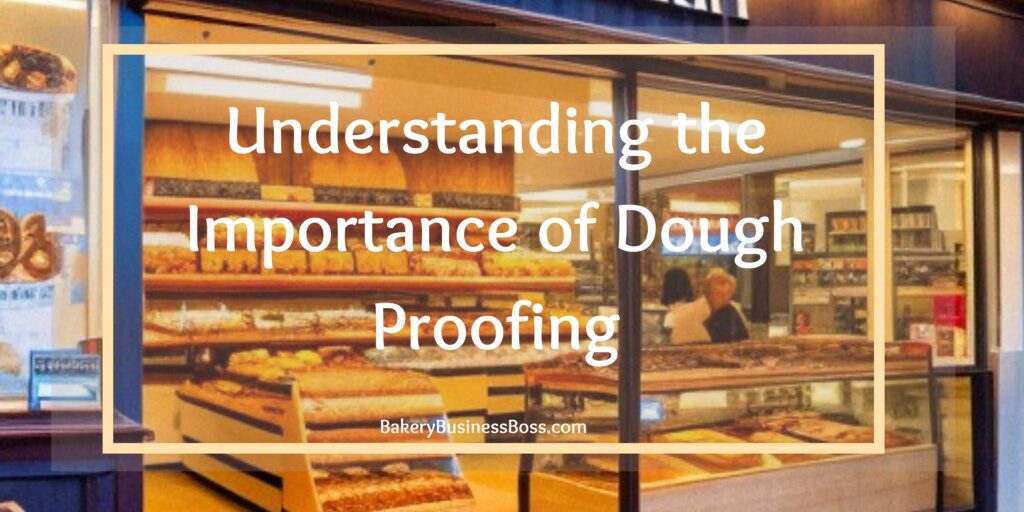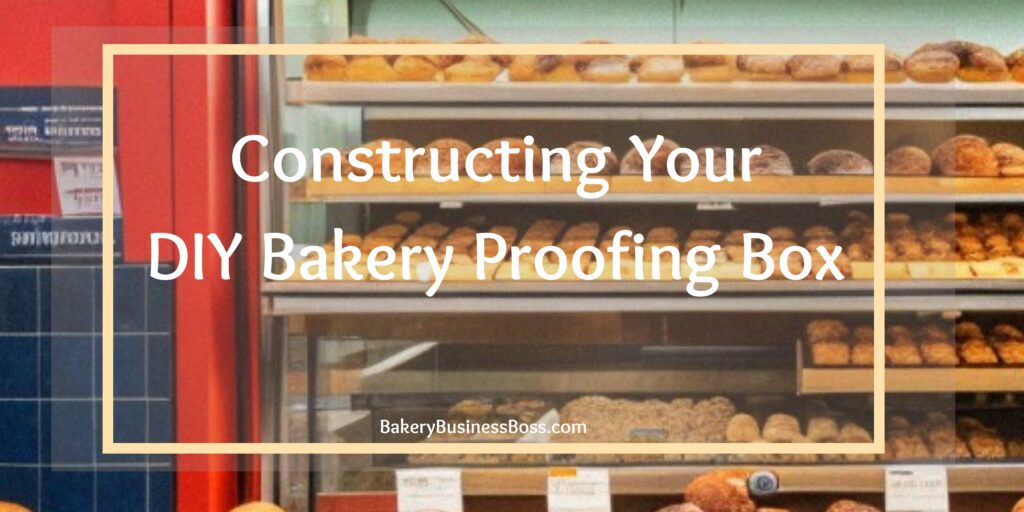For dough proofing, baking bread, and other yeast-based goods requires a warm, controlled environment. Professional bakeries use specialized proofing boxes, but you can easily make your own with a few basic materials.
To make your bakery-proofing box, you’ll need a large plastic storage container, a thermometer, a small bowl of warm water, and a baking rack. Put the frame on top and the dough on it. Close the container, check the thermometer, and adjust the heat.
In this article, we will instruct you on how to make a bakery-proofing box so that you can achieve consistent and remarkable results in your baking endeavors.
Understanding the Importance of Dough Proofing

To produce delicious baked goods with a desirable texture, dough proving is a crucial step in the baking process. The dough goes through major changes during the last fermentation stage, yielding tasty and light sweets.
Yeast, a bacterium found in the dough, breaks down the carbohydrates while proving, creating carbon dioxide gas as a byproduct. The gluten network in the dough expands and raises as a result of the carbon dioxide becoming trapped there. This procedure is what gives bread, rolls, and other yeast-based items their distinctive air pockets and light, fluffy feel.
The process of proving enables the dough to produce carbon dioxide while also allowing for the emergence of rich tastes. Alcohols, acids, and aromatic molecules are among the substances that are released by the yeast during its metabolic process. These byproducts help give the bread that well-proofed flavor that is known for being rich and complex.
Proving is essential for forming the dough’s structure. During fermentation, the dough’s gluten proteins gradually align and solidify, forming an elastic network that can capture and hold the gas bubbles that the yeast produces. The proper shape, volume, and chewy texture of the baked items are provided by this gluten network.
Proper proofing also enhances the baked items’ ability to last. The formation of enzymes during the fermentation process extends the bread’s shelf life and keeps it fresh for longer.
Bakers can comprehend the relevance of creating the ideal atmosphere for dough proving by understanding the significance of dough proofing. By building a DIY proofing box, you can regulate the temperature, humidity, and ventilation, creating the ideal environment for the yeast to grow and produce baked goods with excellent flavor, texture, and rise.
Gather the Necessary Materials

To create your bakery-proofing box, you’ll need a few easily accessible materials. These include:
Big plastic storage container
When choosing a container for your handmade proving box, make sure it is roomy enough to comfortably hold the dough and provide enough space for it to rise. The dough’s ability to expand can be hampered in a small container, leading to dense or irregularly proofed baked items. Additionally, choose a box with sufficient insulation to keep a constant temperature inside the proving box, enabling reliable proofing outcomes.
Thermometer
To monitor and maintain the proper temperature within your proofing box, a dependable thermometer is an essential instrument. For yeast activity and fermentation to occur at their optimum levels, precise temperature control is essential. Using a thermometer, you may check and adjust the temperature frequently to make sure it stays within the range advised for your particular recipe.
Whether you’re using an analog or digital thermometer, be sure it’s calibrated correctly to offer accurate readings. Even little temperature differences can have an impact on how well your baked items turn out throughout the proofing phase.
A small cup of warm water
It’s crucial to have a small bowl of warm water inside the proofing box. The moist atmosphere that is produced by the warm water is crucial for facilitating ideal dough rise. The wetness helps the dough expand evenly and form a nice crust during baking by preventing the surface from drying out too rapidly. The baked foods’ flavor and texture are further enhanced by the humid climate. Keep in mind to check the water level frequently to make sure it doesn’t evaporate and to replenish it if necessary.
Baking rack
There are several benefits to putting a baking rack inside the proofing box. First of all, it prevents direct contact and any sticking by keeping the dough high over the water bowl. By doing this, you can be confident that the dough will keep its structure and shape while it proofs. The second benefit of the baking rack is that it encourages optimal airflow around the dough, enabling equal rising and avoiding any potential condensation buildup.
Additionally, it aids in the equal distribution of heat, producing reliable proofing outcomes. To handle the size and volume of dough you are proving, use a baking rack that fits snugly inside your container.
Constructing Your DIY Bakery Proofing Box

Choose the container
It’s important to pick a container for your homemade proofing box that is clean and devoid of any lingering scents that can have an impact on the flavor of your dough. Choose a container that is simple to clean and sanitize and is constructed of materials that are safe for food. The container’s size should also be taken into account. The dough should have enough room to rise without hitting the lid because it will expand while being proofed. This promotes appropriate ventilation and keeps the dough from adhering to the lid, resulting in a final product that is well-risen and baked uniformly.
Place the bowl of warm water in its proper location
Put a small basin of warm water next to the dough within the container. The proofing process makes use of warm water in a variety of ways. It assists in producing a moist atmosphere inside the box, keeping the dough’s surface from prematurely drying out and developing a crust. The water’s wetness encourages the best possible fermentation, which enables the yeast to flourish and the dough to rise. The baked items’ enhanced texture and flavor development benefit from the humid climate as well.
Add the baking rack
Place the baking rack on top of the container, making sure that it is above the basin of warm water. Your dough rests on the higher surface provided by the baking rack. This avoids the dough’s coming into direct touch with the water, which might alter the dough’s texture. The baking rack creates a space between the dough and the water to allow for appropriate air circulation, which helps the dough proof evenly and rise consistently. Additionally, it contributes to uniform fermentation by distributing heat throughout the container in an even manner.
Preheating the proofing box
It’s crucial to warm the proofing box to the proper temperature before adding your dough inside. Depending on the particular recipe, the appropriate proofing temperature can change, but it normally falls between 75°F and 85°F (24°C and 29°C). Check the temperature inside the box using the thermometer to make sure it reaches and stays within the required range. By preheating the proofing box, you can guarantee that the dough is exposed to the proper conditions right away, promoting the best possible yeast activity and fermentation.
Positioning the dough
Place your prepared dough carefully on the baking rack inside the proving box. Make sure the dough is evenly distributed and stays away from the container’s lid and sides. Each portion of dough should have enough room around it to expand throughout the proving process. The dough won’t clump together and will rise uniformly with proper spacing. Put the cover on the container to create a warm, moist atmosphere that promotes the fermentation and rise of the dough.
Monitoring and adjustments
Throughout the proving process, it’s critical to keep an eye on the temperature inside the proofing box. Utilize the thermometer to check the temperature frequently and adjust as needed. Place a warm cloth or a hot water bottle close to the container to assist preserve warmth if the temperature falls below the required range. To avoid overheating or changing the texture of the dough, make sure these outside heat sources are not in direct contact with it. Consistent and effective proofing depends on monitoring the temperature and making the appropriate modifications.
Proofing time
Depending on the recipe and the desired outcomes, the proofing time can vary. It’s crucial to adhere to the directions listed in your unique recipe as a guide. But throughout the proofing process, it’s also crucial to pay attention to the dough’s look and volume. The size of a properly proofed dough should roughly double. When the proofing procedure is over, you may tell by watching the dough’s growth and looking for the desired rise. Remember that variables like ambient temperature, dough hydration, and yeast activity can affect how long bread needs to proof.
Tips and Considerations

Consistent temperature
A constant temperature must be maintained. It is ideal to position the proofing box away from harsh sunlight and cold surfaces in an area without drafts. These outside variables have a big impact on the temperature inside the box, which has an impact on the proofing procedure. Utilizing additional insulation, such as covering the container with blankets or towels, will also improve temperature control. The dough can rise consistently in a steady atmosphere because of the insulation’s ability to hold onto heat.
Thermometer accuracy
For accurate temperature monitoring, it’s crucial to make sure your thermometer is accurate. Your thermometer should be regularly calibrated to ensure accuracy. The thermometer can be calibrated by placing it in a glass of ice water, which should read 32°F or 0°C, and making any required adjustments. The temperature of boiling water should be 212°F, or 100°C. By calibrating your thermometer, you can prevent temperature inconsistencies and make sure that you are using accurate temperature measurements when proofing.
Humidity control
In addition to temperature, humidity is important for the proofing process, especially for some dough recipes. You might put a damp towel or a small pitcher of water inside the proofing box to raise the humidity level there. It becomes humid because of the evaporation of the water or moisture from the cloth, which keeps the dough’s surface from drying up too soon.
On the other side, if you need to reduce humidity, you can use a dehumidifier or leave the container open. The overall quality of baked items is improved by controlling humidity because it gives bakers better control over the texture and rise of the dough.
Experiment and modify
The proofing needs for each dough recipe may differ. To obtain the ideal conditions for your particular recipes, you must conduct extensive testing with various temperatures, proofing intervals, and humidity levels. Record your observations in a baking journal, noting the temperature, duration, and results of each proofing session. You can use this journal as a useful resource for pastries in the future and make improvements depending on your learnings. You’ll gain a better knowledge of how various aspects affect the proofreading process with time and experience, and you’ll produce consistent and appealing outcomes.
Alternative proofing techniques
If you don’t have access to the supplies needed to make a DIY proofing box, you can try some other techniques. Utilizing your oven with the light on is one alternative. The heat produced by the light bulb may provide a comfortable setting for proofing. To avoid inadvertent activation, take precautions and make sure the oven is off. Utilizing a microwave while keeping a basin of hot water close is an additional choice.
Water’s steam contributes to the humid environment needed for proofing. Once more, be cautious and make sure the microwave is not on. These alternate techniques can be effective, but to obtain ideal circumstances for proofing, it’s crucial to regularly control the temperature and humidity.
Frequently Asked Questions
What are the benefits of proofing in baking?
For the dough to rise, develop taste, and acquire the correct texture, proofing is an important stage in baking. During the proving process, yeast ferments the dough’s sugars to produce carbon dioxide gas, which forms air bubbles and gives baked foods their light and airy texture. Additionally, proofing improves the structure of the gluten, leading to a superior texture and taste.
Can I make a DIY-proofing box out of different materials?
Yes, you can manufacture a temporary proofing box out of other materials if you don’t have a large plastic storage container. For instance, you may use a well-insulated, clean, food-safe cardboard box that is lined with a plastic bag. Just make sure the container you select can keep a steady temperature and is big enough for the dough.
At what temperature and for how long should proofing be done?
According to the recipe and intended outcomes, the optimal proofing temperature varies, although it typically ranges from 75°F to 85°F (24°C to 29°C). The ideal conditions for yeast activity and fermentation fall within this temperature range. It’s vital to follow the directions given because various recipes may call for somewhat different temperatures.
The proving period varies as well; it usually lasts between one and two hours, but it can be shorter or longer depending on the ambient temperature and the particular dough recipe. Watch the dough’s appearance and volume closely since during the proofing process, it should be about double in size.
To learn more on how to start your own bakery business check out my startup documents here
Please note that the contents of this blog are for informational and entertainment purposes only and should not be construed as legal advice. Any action taken based on the information provided in this blog is solely at your own risk. Additionally, all images used in this blog are generated under the CC0 license of Creative Commons, which means they are free to use for any purpose without attribution.

About the author. Entrepreneur and Bakery Business Fan.
Hi! I am Shawn and I am a happy individual who happens to be an entrepreneur. I have owned several types of businesses in my life from a coffee shop to an import and export business to an online review business plus a few more and now I create online bakery business resources for those interested in starting new ventures. It’s demanding work but I love it. I do it for those passionate about their business and their goals. That’s why when I meet a bakery business owner, I see myself. I know how hard the struggle is to retain customers, find good employees and keep the business growing all while trying to stay competitive.
That’s why I created Bakery Business Boss: I want to help bakery business owners like you build a thriving business that brings you endless joy and supports your ideal lifestyle.

